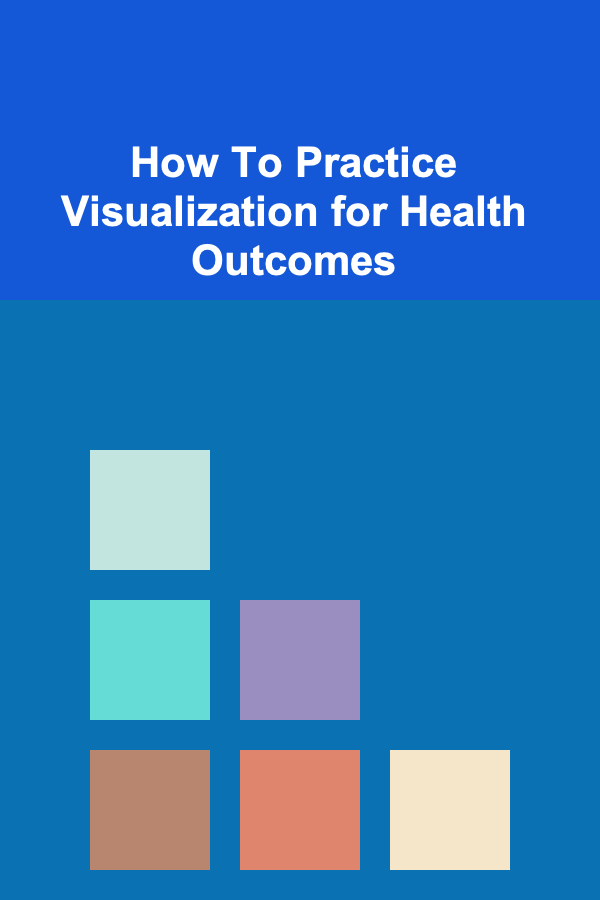
How To Practice Visualization for Health Outcomes
ebook include PDF & Audio bundle (Micro Guide)
$12.99$11.99
Limited Time Offer! Order within the next:

Visualization is a powerful mental technique that can significantly improve your health and well-being. The concept of visualization---often referred to as mental imagery or guided imagery---has been widely used in various fields, including psychology, sports, and medicine. It involves imagining specific images, scenarios, or feelings to enhance physical or emotional health. This article will explore the science behind visualization, its applications in health, and a detailed guide on how to practice it for better health outcomes.
The Science Behind Visualization
Visualization works based on the principle that the brain does not differentiate between real and vividly imagined experiences. When you visualize something---whether it's an activity or a positive outcome---the brain activates similar neural pathways that are involved when you're physically doing it. This can lead to a series of physical and emotional changes in the body that promote healing, enhance performance, and reduce stress.
The Mind-Body Connection
The mind and body are intricately connected. The mind influences bodily functions through the central nervous system and can trigger the release of certain hormones, such as endorphins and cortisol. Positive thoughts, emotions, and mental imagery can stimulate the production of beneficial hormones that enhance health, while negative thoughts can lead to stress and inflammation, which can hinder the body's ability to heal.
In medical settings, research has shown that visualization can help improve outcomes for patients undergoing surgeries, cancer treatments, and managing chronic pain. Athletes also use visualization to enhance their performance by mentally rehearsing their movements, resulting in improved coordination, strength, and focus.
Neuroplasticity and Visualization
Neuroplasticity refers to the brain's ability to reorganize itself by forming new neural connections throughout life. Visualization aids in neuroplasticity by stimulating specific areas of the brain. When you visualize an activity or health outcome, your brain forms neural connections as if you're actually experiencing it. Over time, repeated visualization can help reshape the brain, making your imagined experiences feel more real and potentially impacting your physical health.
The Role of the Subconscious Mind
The subconscious mind plays a major role in the effectiveness of visualization. It controls many of the body's automatic processes, such as breathing and heartbeat, and it stores deeply held beliefs and emotions. Visualization taps into the subconscious mind, influencing beliefs about health, illness, and recovery. By repeatedly visualizing positive health outcomes, you can shift limiting beliefs about your health and replace them with empowering ones, ultimately improving your physical state.
How Visualization Can Improve Health Outcomes
Visualization is a versatile tool that can be applied to various health-related scenarios. Below are some key areas in which it can have a significant impact:
1. Stress Reduction
Chronic stress can wreak havoc on your health, contributing to conditions like heart disease, high blood pressure, and immune system suppression. Visualization has been shown to reduce stress by calming the nervous system. Guided imagery, where you imagine peaceful and calming scenes, can trigger the relaxation response, lowering stress levels and promoting overall health.
2. Pain Management
Visualization can be used as an effective pain management technique. When you visualize the pain leaving your body or imagine it dissipating like a cloud, you can reduce your perception of pain. Studies have shown that patients who use visualization techniques report lower levels of pain and discomfort, especially in the case of chronic pain conditions, like fibromyalgia or migraines.
3. Immune System Boost
Visualization can strengthen your immune system by imagining your body fighting off illness. Research suggests that when people visualize their immune system working at full capacity, it can enhance the activity of immune cells and improve the body's ability to fight infections. This is particularly beneficial for people undergoing cancer treatments or those recovering from surgery.
4. Healing After Surgery or Injury
One of the most well-known uses of visualization is in promoting faster recovery after surgery or injury. By imagining the body healing itself and visualizing the tissues and cells regenerating, you can accelerate the healing process. Visualization has been shown to improve outcomes in surgical recovery by reducing inflammation, minimizing pain, and speeding up the repair of injured tissues.
5. Mental Health and Emotional Healing
Visualization is an excellent tool for promoting emotional well-being. By visualizing yourself in peaceful and joyful situations, you can help lift your mood, reduce anxiety, and alleviate depression. Positive mental imagery can help release trapped emotions and foster emotional healing, leading to a more balanced and healthy life.
6. Enhancing Sleep Quality
For individuals struggling with insomnia or poor sleep quality, visualization can help improve sleep by calming the mind before bed. Imagining peaceful landscapes or a calming scenario can help reduce anxiety and prepare the body for restful sleep. The mental imagery of a relaxed state can lower heart rate and induce a deeper, more restorative sleep cycle.
A Step-by-Step Guide on How to Practice Visualization for Health Outcomes
Practicing visualization for health is simple and accessible to anyone, regardless of age or health status. Here's a step-by-step guide to help you incorporate this technique into your daily routine for better health outcomes:
Step 1: Find a Quiet Space
Choose a quiet and comfortable space where you won't be disturbed. This could be your bedroom, a cozy corner of your living room, or even a peaceful outdoor setting. Make sure the environment is free of distractions, allowing you to focus solely on your visualization.
Step 2: Relax Your Body
Begin by sitting or lying down in a relaxed position. Close your eyes and take a few deep breaths, inhaling slowly through your nose and exhaling through your mouth. As you breathe, consciously relax each part of your body, starting from your toes and working your way up to your head. Release any tension you may be holding in your muscles.
Step 3: Focus on Your Health Goal
Now, think about a specific health outcome you want to achieve. This could be anything from reducing stress, alleviating pain, improving sleep, or recovering from an injury. Be clear about your goal and hold it in your mind. The more specific your goal, the better your visualization will be.
Step 4: Create a Vivid Mental Image
Begin to create a vivid mental image of the desired outcome. If your goal is to reduce stress, imagine yourself in a serene and peaceful environment, such as a beach or a forest. Picture every detail---what you see, hear, smell, and feel in that environment. If your goal is pain relief, visualize the pain leaving your body as a cloud or energy that dissipates into the air.
Step 5: Engage All Your Senses
The more senses you involve in your visualization, the more powerful it will be. Imagine the colors, sounds, smells, and sensations of your desired health outcome. If you're visualizing healing after surgery, imagine the feeling of your body becoming stronger and more energized. Engaging all your senses makes the visualization more real, thus triggering a stronger response from your brain.
Step 6: Repeat and Reinforce
Visualization is most effective when practiced regularly. Set aside time each day to visualize your health goals. The more often you do it, the more you strengthen the neural pathways associated with your desired outcome. It's important to stay consistent, as repetition helps to program the mind for success.
Step 7: Incorporate Positive Affirmations
While visualizing, incorporate positive affirmations that support your health goals. For example, you might say to yourself, "I am healthy and strong," or "My body is healing and regenerating." These affirmations reinforce the positive imagery and help you believe in the possibility of achieving your desired health outcomes.
Step 8: Trust the Process
Visualization requires patience and trust. Understand that it may take time for you to notice significant changes in your health. Trust the process and remain committed to practicing visualization, knowing that it is gradually influencing your mind and body in positive ways.
Overcoming Challenges with Visualization
While visualization is a highly effective tool, there are common challenges that people may face when practicing it. Here are some tips to overcome them:
1. Difficulty Focusing
If you find it difficult to focus, try starting with shorter sessions. Begin with just a few minutes of visualization, and gradually increase the time as you get better at concentrating. You can also listen to guided meditation recordings that lead you through the process.
2. Doubts or Skepticism
It's normal to feel skeptical, especially if you're new to the practice. However, keep in mind that the science behind visualization is sound. The more you practice, the more you'll experience the positive effects, which can help build confidence in its power.
3. Negative Thoughts
If negative thoughts arise during your visualization, gently redirect your focus back to the positive images you want to create. Acknowledge the negative thoughts without judgment, and then refocus on the healing, positive outcome you desire.
Conclusion
Visualization is an effective and accessible tool that can have a profound impact on your health outcomes. By harnessing the power of the mind-body connection, you can reduce stress, manage pain, accelerate healing, and improve emotional well-being. Through consistent practice and mental imagery, you can influence your health in powerful ways. Remember to start small, stay patient, and trust the process as you embark on your journey toward better health.

How to Celebrate Your Budgeting Successes and Learn from Mistakes
Read More
How to Clean Your Home Using Eco-Friendly Products
Read More
How to Make Money Online as a Discord Community Manager: 10 Actionable Ideas
Read More
How to Use Color Coding for Meal Prep Ingredients
Read More
How to Understand the Fundamentals of Altcoins
Read More
10 Tips for a Productive Weekly To-Do List for Freelancers
Read MoreOther Products

How to Celebrate Your Budgeting Successes and Learn from Mistakes
Read More
How to Clean Your Home Using Eco-Friendly Products
Read More
How to Make Money Online as a Discord Community Manager: 10 Actionable Ideas
Read More
How to Use Color Coding for Meal Prep Ingredients
Read More
How to Understand the Fundamentals of Altcoins
Read More